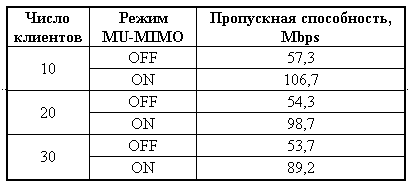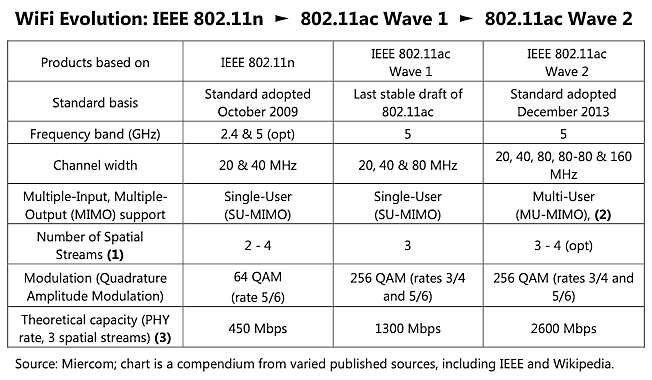New Cisco Aironet IEEE 802.11ac Wave 2 Access Points
During 2012-13. More than 200 products that meet the 802.11ac specification have appeared on the market. This product range is now referred to as Wave 1.
The IEEE 802.11 WiFi Wave 2 specification is the latest officially approved version of the IEEE 802.11ac standard. The bright representatives of Wave 2 are the access points of the Cisco Aironet 1830 series and the Cisco Aironet 1850.

Appearance and Main Features of Cisco Aironet 1830 Series Access Point
')

* Compared to the previous 802.11ac Wave 1 Aironet 1700 Series Access Point
Appearance and Main Features of Cisco Aironet 1850 Series Access Point
A source
Comparative characteristics of access points of the 1700 and 1800 series

A source
Comparative testing of Multi-User MIMO (MU-MIMO) and Single-User MIMO (SU-MIMO) modes


Test parameters for Cisco Aironet 1830 & 1850 access points and Cisco AP 3702i models
SS - Spatial Streams (spatial streams)
SU-MIMO - Single-User Multiple Input, Multiple Output
MU-MIMO - Multiple-User Multiple Input, Multiple Output, a unique feature of 802.11ac Wave 2.
3x3,4x4 - 3x3 MIMO APs have three antennas and three transceivers; 4x4 - four and four.
The MIMO (Multiple Input, Multiple Output) features were implemented in 802.11n and 802.11ac Wave 1 products, but only in single-user mode (SU-MIMO). Multi-User Mode (MU-MIMO) is a new feature that appeared only in 802.11ac Wave 2. MU-MIMO allows more efficient use of currently free transmitters.


Cisco 1852i Multi-User Mode Bandwidth Test
Sources 1 and 2
Mobility Express for small and medium companies
The Cisco Mobility Express Solution is specifically designed to help small and medium-sized networks easily and cost-effectively provide their employees and customers with enterprise-class wireless access. With the Mobility Express solution, small and medium-sized networks can now have the same quality features as large corporate networks.

The Cisco Mobility Express Solution is ideal for small and medium deployments. It can be completed in less than 10 minutes and does not require a separate physical controller device. At the same time, it is possible to control other access points of the Aironet 1700, 2700 and 3700 series.
A source

Key benefits of Cisco Mobility Express Solution. The solution is regularly deployed on access points of the Cisco Aironet 1830 and 1850 series. It manages up to 25 access points that can be added as the network grows. All you need to do is three simple steps using the Setup Wizard software.

Cisco Aironet 1850 Series Performance Monitoring Screen in Cisco Mobility Express Software.
A source
See in detail the entire process of deploying Mobility Express can be seen on YouTube in the next video . Shown here is the bundle, as well as a simple setup of the solution in the corresponding software
Additional Information
The full technical specifications of the Cisco Aironet 1830 Series and Cisco Aironet 1850 Series are presented here and here, respectively.
The 1800 series models are represented by two access points - 1832 and 1852 (the first two lines of the table). Their difference is that 1832 is available only with internal antennas, and 1852 - with internal and external. The second difference is in the number of spatial streams (2 and 4), MIMO modes (3x3 and 4x4) and, as a result, in the maximum data exchange rate. Access point 1832 provides up to 860 Mbps, 1852 - up to 1.7 Gbit / s.
All access points of the 1800 series are powered using PoE (Power over Ethernet) technology. For points 1832, PoE class 3 (15.4 W) is sufficient. Points 1852 to work with full transceiver power need increased PoE power (25.5 W).
Both access points can also be powered by a power supply or power injectors. For points 1852, AIR-PWRINJ4 high-power injectors are used, but they can also work with AIR-PWRINJ5 at lower speeds, since not all transceivers are active at the same time.
Dimensions and weight of devices do not depend on the model. The point itself and its mount are included in the kit.
Application. The development of Wi-Fi standards IEEE 802.11
The final edition of the 802.11ac Wave 2 standard (end of 2013) includes some improved technical characteristics of devices that were not included in the 802.11ac Wave 1 edition. In 2014, Wave 2 products appeared on the market.

Evolution of IEEE 802.11 standards
The benefits of 802.11ac Wave 2 over 802.11ac Wave 1 and other earlier WiFi standards can be summarized in the following four points.
- Higher data transfer rate - up to 2.6 Gbps in the 5 GHz band.
- Support Multi-User MIMO (Multiple-Input, Multiple Output).
- Support for channel width of 160 MHz, which is a key feature for providing increased data transfer speeds.
- Fourth Spatial Stream: supports four antennas and streams compared to three for Wave 1 devices.
802.11ac Wave 1 and Wave 2 products are fully compatible with each other.
The IEEE 802.11 WiFi Wave 2 specification is the latest officially approved version of the IEEE 802.11ac standard. The bright representatives of Wave 2 are the access points of the Cisco Aironet 1830 series and the Cisco Aironet 1850.

Appearance and Main Features of Cisco Aironet 1830 Series Access Point
')

* Compared to the previous 802.11ac Wave 1 Aironet 1700 Series Access Point
Appearance and Main Features of Cisco Aironet 1850 Series Access Point
A source
Comparative characteristics of access points of the 1700 and 1800 series

A source
Comparative testing of Multi-User MIMO (MU-MIMO) and Single-User MIMO (SU-MIMO) modes


Test parameters for Cisco Aironet 1830 & 1850 access points and Cisco AP 3702i models
SS - Spatial Streams (spatial streams)
SU-MIMO - Single-User Multiple Input, Multiple Output
MU-MIMO - Multiple-User Multiple Input, Multiple Output, a unique feature of 802.11ac Wave 2.
3x3,4x4 - 3x3 MIMO APs have three antennas and three transceivers; 4x4 - four and four.
The MIMO (Multiple Input, Multiple Output) features were implemented in 802.11n and 802.11ac Wave 1 products, but only in single-user mode (SU-MIMO). Multi-User Mode (MU-MIMO) is a new feature that appeared only in 802.11ac Wave 2. MU-MIMO allows more efficient use of currently free transmitters.


Cisco 1852i Multi-User Mode Bandwidth Test
Sources 1 and 2
Mobility Express for small and medium companies
The Cisco Mobility Express Solution is specifically designed to help small and medium-sized networks easily and cost-effectively provide their employees and customers with enterprise-class wireless access. With the Mobility Express solution, small and medium-sized networks can now have the same quality features as large corporate networks.

The Cisco Mobility Express Solution is ideal for small and medium deployments. It can be completed in less than 10 minutes and does not require a separate physical controller device. At the same time, it is possible to control other access points of the Aironet 1700, 2700 and 3700 series.
A source

Key benefits of Cisco Mobility Express Solution. The solution is regularly deployed on access points of the Cisco Aironet 1830 and 1850 series. It manages up to 25 access points that can be added as the network grows. All you need to do is three simple steps using the Setup Wizard software.

Cisco Aironet 1850 Series Performance Monitoring Screen in Cisco Mobility Express Software.
A source
See in detail the entire process of deploying Mobility Express can be seen on YouTube in the next video . Shown here is the bundle, as well as a simple setup of the solution in the corresponding software
Additional Information
The full technical specifications of the Cisco Aironet 1830 Series and Cisco Aironet 1850 Series are presented here and here, respectively.
The 1800 series models are represented by two access points - 1832 and 1852 (the first two lines of the table). Their difference is that 1832 is available only with internal antennas, and 1852 - with internal and external. The second difference is in the number of spatial streams (2 and 4), MIMO modes (3x3 and 4x4) and, as a result, in the maximum data exchange rate. Access point 1832 provides up to 860 Mbps, 1852 - up to 1.7 Gbit / s.
All access points of the 1800 series are powered using PoE (Power over Ethernet) technology. For points 1832, PoE class 3 (15.4 W) is sufficient. Points 1852 to work with full transceiver power need increased PoE power (25.5 W).
Both access points can also be powered by a power supply or power injectors. For points 1852, AIR-PWRINJ4 high-power injectors are used, but they can also work with AIR-PWRINJ5 at lower speeds, since not all transceivers are active at the same time.
Dimensions and weight of devices do not depend on the model. The point itself and its mount are included in the kit.
Application. The development of Wi-Fi standards IEEE 802.11
The final edition of the 802.11ac Wave 2 standard (end of 2013) includes some improved technical characteristics of devices that were not included in the 802.11ac Wave 1 edition. In 2014, Wave 2 products appeared on the market.

Evolution of IEEE 802.11 standards
The benefits of 802.11ac Wave 2 over 802.11ac Wave 1 and other earlier WiFi standards can be summarized in the following four points.
- Higher data transfer rate - up to 2.6 Gbps in the 5 GHz band.
- Support Multi-User MIMO (Multiple-Input, Multiple Output).
- Support for channel width of 160 MHz, which is a key feature for providing increased data transfer speeds.
- Fourth Spatial Stream: supports four antennas and streams compared to three for Wave 1 devices.
802.11ac Wave 1 and Wave 2 products are fully compatible with each other.
Source: https://habr.com/ru/post/281362/
All Articles